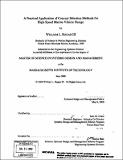A practical application of concept selection methods for high-speed marine vehicle design
Author(s)
Hagan, William L. (William Laurie), III
DownloadFull printable version (13.66Mb)
Other Contributors
System Design and Management Program.
Advisor
John M. Grace.
Terms of use
Metadata
Show full item recordAbstract
Naval ship design and construction has been in existence for thousands of years. Over that time, many tools have been developed to aid naval architects in the quest for an optimal design, whether fast and sleek like a racing boat or big and square like an oil tanker. In any case, the basic naval architecture design principles are the same. The following thesis discusses the use of systems engineering principles, including the Pugh concept selection tool and design spiral methodology. Additionally, Chapter 3 provides an example of those principles and methods as they are applied to the hull design for a high-speed naval vehicle. The combination of system engineering principles and methods provided a rapid convergence to a feasible hull design that exemplified the methods taught in the Systems Design and Management program. Furthermore, recommendations are made for the future of naval vessel design through the use of genetic algorithms for an accurate representation of the value of "real options" as they may apply to marine vessel design.
Description
Thesis (S.M.)--Massachusetts Institute of Technology, System Design and Management Program, 2008. Includes bibliographical references (leaves 64-66).
Date issued
2008Department
System Design and Management Program.Publisher
Massachusetts Institute of Technology
Keywords
System Design and Management Program.